Molecular Dynamics Approaches Dissect Molecular Mechanisms Underlying Methylene Blue–Glycosaminoglycan Interactions
Abstract
:1. Introduction
2. Materials and Methods
2.1. Structures’ and Parameters’ Preparation
2.2. Molecular Dynamics
2.3. Free Energy MM-GBSA Analysis and per Residue Decomposition
3. Results
3.1. MM–GBSA Analysis
3.2. The Sulfation Pattern Dependence
3.3. MB–GAG Distance Analysis
4. Conclusions
Supplementary Materials
Author Contributions
Funding
Institutional Review Board Statement
Informed Consent Statement
Data Availability Statement
Acknowledgments
Conflicts of Interest
Sample Availability
References
- Karamanos, N.K.; Theocharis, A.D.; Piperigkou, Z.; Manou, D.; Passi, A.; Skandalis, S.S.; Vynios, D.H.; Orian-Rousseau, V.; Ricard-Blum, S.; Schmelzer, C.E.H.; et al. A guide to the composition and functions of the extracellular matrix. FEBS J. 2021, 288, 6850–6912. [Google Scholar] [CrossRef] [PubMed]
- Tracy, L.E.; Minasian, R.A.; Caterson, E.J. Extracellular matrix and dermal fibroblast function in the healing wound. Adv. Wound Care 2016, 5, 119–136. [Google Scholar] [CrossRef]
- Smock, R.G.; Meijers, R. Roles of glycosaminoglycans as regulators of ligand/receptor complexes. Open Biol. 2018, 8, 180026. [Google Scholar] [CrossRef] [PubMed] [Green Version]
- Bauer, S.; Zhang, F.; Linhardt, R.J. Implications of glycosaminoglycans on viral zoonotic diseases. Diseases 2021, 9, 85. [Google Scholar] [CrossRef] [PubMed]
- Almer, J.; Gesslbauer, B.; Kungl, A.J. Therapeutic strategies to target microbial protein-glycosaminoglycan interactions. Biochem. Soc. Trans. 2018, 46, 1505–1515. [Google Scholar] [CrossRef] [PubMed]
- Crijns, H.; Vanheule, V.; Proost, P. Targeting chemokine-glycosaminoglycan interactions to inhibit inflammation. Front. Immunol. 2020, 11, 483. [Google Scholar] [CrossRef] [PubMed]
- Marques, C.; Reis, C.A.; Vivès, R.R.; Magalhães, A. Heparan sulfate biosynthesis and sulfation profiles as modulators of cancer signalling and progression. Front. Oncol. 2021, 11, 778752. [Google Scholar] [CrossRef]
- Jin, W.; Zhang, F.; Linhardt, R.J. Glycosaminoglycans in neurodegenerative diseases. Adv. Exp. Med. Biol. 2021, 1325, 189–204. [Google Scholar] [CrossRef]
- Snow, A.D.; Cummings, J.A.; Lake, T. The unifying hypothesis of Alzheimer’s disease: Heparan sulfate proteoglycans/glycosaminoglycans are key as first hypothesized over 30 years ago. Front. Aging Neurosci. 2021, 13, 710683. [Google Scholar] [CrossRef]
- Künze, G.; Huster, D.; Samsonov, S.A. Investigation of the structure of regulatory proteins interacting with glycosaminoglycans by combining NMR spectroscopy and molecular modeling- the beginning of a wonderful friendship. Biol. Chem. 2021, 402, 1337–1355. [Google Scholar] [CrossRef]
- da Silva, P.H.R.; Borges, B.C.; Uehara, I.A.; Soldi, L.R.; de Araújo, R.A.; Silva, M.J.B. Chemokines and the extracellular matrix: Set of targets for tumor development and treatment. Cytokine 2021, 144, 155548. [Google Scholar] [CrossRef] [PubMed]
- Zsila, F. The anticancer agent ellipticine binds to glycosaminoglycans at mildly acidic pH characteristic of the extracellular matrix of tumor tissues. RSC Adv. 2016, 6, 810–814. [Google Scholar] [CrossRef]
- Zsila, F.; Samsonov, S.A. Molecular interactions of the anticancer agent ellipticine with glycosaminoglycans by in silico analysis. Carbohydr. Res. 2018, 462, 28–33. [Google Scholar] [CrossRef] [PubMed]
- Maszota-Zieleniak, M.; Zsila, F.; Samsonov, S.A. Computational insights into heparin-small molecule interactions: Evaluation of the balance between stacking and non-stacking binding modes. Carbohydr. Res. 2021, 507, 108390. [Google Scholar] [CrossRef] [PubMed]
- Zsila, F.; Juhasz, T.; Kohut, G.; Beke-Somfai, T. Heparin and heparan sulfate binding of the antiparasitic drug imidocarb: Circular dichroism spectroscopy, isothermal titration calorimetry, and computational studies. J. Phys. Chem. B 2018, 122, 1781–1791. [Google Scholar] [CrossRef] [PubMed]
- Zsila, F.; Gedeon, G. Binding of anti-prion agents to glycosaminoglycans: Evidence from electronic absorption and circular dichroism spectroscopy. Biochem. Biophys. Res. Commun. 2006, 346, 1267–1274. [Google Scholar] [CrossRef]
- Zsila, F. Glycosaminoglycan and DNA binding induced intra- and intermolecular exciton coupling of the bis-4-aminoquinoline surfen. Chirality 2015, 27, 605–612. [Google Scholar] [CrossRef] [Green Version]
- Zsila, F. Glycosaminoglycans are potential pharmacological targets for classic DNA minor groove binder drugs berenil and pentamidine. Phys. Chem. Chem. Phys. 2015, 17, 24560–24565. [Google Scholar] [CrossRef] [Green Version]
- Juhas, S.; Harris, N.; Il’kova, G.; Rehak, P.; Zsila, F.; Kogan, F.Y.; Lahmy, O.; Zhuk, R.; Gregor, P.; Koppel, J. RX-207, a small molecule inhibitor of protein interaction with glycosaminoglycans (SMIGs), reduces experimentally induced inflammation and increases survival rate in cecal ligation and puncture (CLP)-induced sepsis. Inflammation 2018, 41, 307–314. [Google Scholar] [CrossRef] [Green Version]
- Zsila, F.; Samsonov, S.A.; Maszota-Zieleniak, M. Mind your dye: The amyloid sensor thioflavin T interacts with sulfated glycosaminoglycans used to induce cross-b-sheet motifs. J. Phys. Chem. B 2020, 124, 11625–11633. [Google Scholar] [CrossRef]
- Templeton, D.M. The basis and applicability of the dimethylmethylene blue binding assay for sulfated glycosaminoglycans, Connect. Tissue Res. 1988, 17, 23–32. [Google Scholar] [CrossRef] [PubMed]
- Marson, D.; Laurini, E.; Fermeglia, M.; Smith, D.K.; Pricl, S. Mallard Blue binding to heparin, its SDS micelle-driven decomplexation, and interaction with human serum albumin: A combined experimental/modeling investigation. Fluid Phase Equilibr. 2018, 470, 259–267. [Google Scholar] [CrossRef] [Green Version]
- Stone, A.L.; Bradley, D.F. Aggregation of cationic dyes on acid polysaccharides. I. Spectrophotometric titration with acridine orange and other metachromatic dyes. Biochim. Biophys. Acta 1967, 148, 172–192. [Google Scholar] [CrossRef]
- Ansell, J.; Laulicht, B.E.; Bakhru, S.H.; Burnett, A.; Jiang, X.; Chen, L.; Baker, C.; Villano, S.; Steiner, S. Ciraparantag, an anticoagulant reversal drug: Mechanism of action, pharmacokinetics, and reversal of anticoagulants. Blood 2021, 137, 115–125. [Google Scholar] [CrossRef]
- Pal, M.K.; Biswas, M. Small molecules as chromotropes in metachromasia. Histochemie 1971, 27, 36–42. [Google Scholar] [CrossRef] [PubMed]
- Kugel, R.W. Metachromasy: The Interactions between Dyes and Polyelectrolytes in Aqueous Solution; Urban, M.W., Craver, C.D., Eds.; Structure-Property Relations in Polymers-Spectroscopy and Performance; American Chemical Society: Washington, DC, USA, 1993; pp. 507–533. [Google Scholar]
- Dimlich, R.V.; Meineke, H.A.; Reilly, F.D.; McCuskey, R.S. The fluorescent staining of heparin in mast cells using berberine sulfate: Compatibility with paraformaldehyde or o-phthalaldehyde induced fluorescence and metachromasia. Stain Technol. 1980, 55, 217–223. [Google Scholar] [CrossRef] [PubMed]
- Cundall, R.B.; Lawton, J.B.; Murray, D.; Phillips, G.O. The role of co-operativity in determining the binding behaviour of hetero-charged polyanions with metachromatic dyes. Makromol. Chem. 1979, 180, 383–388. [Google Scholar] [CrossRef]
- Ribatti, D. The staining of mast cells: A historical overview. Int. Arch. Allergy Immunol. 2018, 176, 55–60. [Google Scholar] [CrossRef]
- Zhang, T.J.; Zhang, R.; Lv, Y.Q.; Wang, M.; Li, H.M.; Tan, T.W.; Li, J.P. Glycosaminoglycans in biological samples-Towards identification of novel biomarkers. Trends Anal. Chem. 2020, 122, 115732. [Google Scholar] [CrossRef]
- Wang, J.; Chen, F.; Arconada-Alvarez, S.J.; Hartanto, J.; Yap, L.P.; Park, R.; Wang, F.; Vorobyova, I.; Dagliyan, G.; Conti, P.S.; et al. A nanoscale tool for photoacoustic-based measurements of clotting time and therapeutic drug monitoring of heparin. Nano Lett. 2016, 16, 6265–6271. [Google Scholar] [CrossRef]
- Luger, P.; Dittrich, B.; Benecke, L.; Sterzel, H. Charge density studies on methylene blue—A potential anti-Alzheimer agent. Z. Für Nat. B 2018, 73, 99–108. [Google Scholar] [CrossRef]
- Wei, W.; Wei, M.; Kang, X.J.; Wang, P.; Liu, S.Q. Spectrophotometry study of interaction of hyaluronic acid with methylene blue and its analytic application. Anal. Lett. 2008, 41, 599–607. [Google Scholar] [CrossRef]
- Jiao, Q.C.; Liu, Q. Characterization of the interaction between methylene blue and glycosaminoglycans. Spectrochim. Acta A 1999, 55, 1667–1673. [Google Scholar] [CrossRef]
- Jia, S.X.; Chi, Q.N.; Zhang, Y.; Liu, T.; Kou, X.; Wang, F.; Qi, Y.K.; Du, S.S.; Xing, X.H. Binding ability of methylene blue with heparin dependent on its sulfate level rather than its sulfation location or basic saccharide structure. Glycoconj. J. 2021, 38, 551–560. [Google Scholar] [CrossRef] [PubMed]
- Wang, J.; Jeevarathinam, A.S.; Humphries, K.; Jhunjhunwala, A.; Chen, F.; Hariri, A.; Miller, B.R., 3rd; Jokerst, J.V. A mechanistic investigation of methylene blue and heparin interactions and their photoacoustic enhancement. Bioconjugate Chem. 2018, 29, 3768–3775. [Google Scholar] [CrossRef]
- Zhang, L.; Li, N.; Zhao, F.; Li, K. Spectroscopic study on the interaction between methylene blue and chondroitin 4-sulfate and its analytical application. Anal. Sci. 2004, 20, 445–450. [Google Scholar] [CrossRef] [PubMed] [Green Version]
- Németh-Csóka, M.; Kajtár, J.; Kajtár, M. Biological significance of helical conformation of acid polysaccharides, Connect. Tissue Res. 1975, 3, 207–211. [Google Scholar] [CrossRef]
- Pal, M.K.; Chaudhuri, M. Conductometric titrations of anionic polyelectrolytes with metachromatic dyes and effects of organic solvents. Makromol. Chem. 1970, 133, 151–160. [Google Scholar] [CrossRef]
- Schirmer, R.H.; Adler, H.; Pickhardt, M.; Mandelkow, E. Lest we forget you—Methylene blue... Neurobiol. Aging 2011, 32, 2325.e7–2325.e16. [Google Scholar] [CrossRef]
- Zheng, C.H.; Levenston, M.E. Fact versus artifact: Avoiding erroneous estimates of sulfated glycosaminoglycan content using the dimethylmethylene blue colorimetric assay for tissue-engineered constructs. Eur. Cell. Mater. 2015, 29, 224–236, discussion 236. [Google Scholar] [CrossRef]
- Shrikanth, C.B.; Sanjana, J.; Chilkunda, N.D. One-pot analysis of sulfated glycosaminoglycans. Glycoconj. J. 2018, 35, 129–137. [Google Scholar] [CrossRef] [PubMed]
- Lawton, J.B.; Phillips, G.O. The role of water in the metachromatic reaction. Makromol. Chem. 1982, 183, 1497–1509. [Google Scholar] [CrossRef]
- Hanwell, M.D.; Curtis, D.E.; Lonie, D.C.; Vandermeersch, T.; Zurek, E.; Hutchison, G.R. Avogadro: An advanced semantic chemical editor, visualization, and analysis platform. J. Cheminformatics 2012, 4, 17. [Google Scholar] [CrossRef] [PubMed] [Green Version]
- Jakalian, A.; Jack, D.B.; Bayly, C.I. Fast, efficient generation of high-quality atomic charges. AM1-BCC model: II. Parameterization and validation. J. Comput. Chem. 2002, 23, 1623–1641. [Google Scholar] [CrossRef]
- Wang, J.; Wolf, R.M.; Caldwell, J.W.; Kollman, P.A.; Case, D.A. Development and testing of a general amber force field. J. Comput. Chem. 2004, 25, 1157–1174. [Google Scholar] [CrossRef]
- Samsonov, S.A.; Bichmann, L.; Pisabarro, M.T. Coarse-Grained Model of Glycosaminoglycans. J. Chem. Inf. Model. 2015, 55, 114–124. [Google Scholar] [CrossRef]
- Pichert, A.; Schlorke, D.; Franz, S.; Arnhold, J. Functional Aspects of the Interaction between Interleukin-8 and Sulfated Glycosaminoglycans. Biomatter 2012, 2, 142–148. [Google Scholar] [CrossRef] [Green Version]
- Case, D.A. AMBER 2017; University of California: San Francisco, CA, USA, 2017. [Google Scholar]
- Kirschner, K.N.; Yongye, A.B.; Tschampel, S.M.; González-Outeiriño, J.; Daniels, C.R.; Foley, B.L.; Woods, R.J. GLYCAM06: A generalizable biomolecular force field. Carbohydrates J. Comput. Chem. 2008, 29, 622–655. [Google Scholar] [CrossRef] [Green Version]
- Jorgensen, W.L.; Chandrasekhar, J.; Madura, J.D.; Impey, R.W.; Klein, M.L. Comparison of simple potential functions for simulating liquid water. J. Chem. Phys. 1983, 79, 926–935. [Google Scholar] [CrossRef]
- Samsonov, S.A.; Freza, S.; Zsila, F. In silico analysis of heparin and chondroitin sulfate binding mechanisms of the antiprotozoal drug berenil and pentamidine. Carbohydr. Res. 2019, 482, 107742. [Google Scholar] [CrossRef]
- Ryckaert, J.P.; Ciccotti, G.; Berendsen, H.J. Numerical integration of the cartesian equations of motion of a system with constraints: Molecular dynamics of n-alkanes. J. Comput. Phys. 1977, 23, 327–341. [Google Scholar] [CrossRef] [Green Version]
- Essmann, U.; Perera, L.; Berkowitz, M.L.; Darden, T.; Lee, H.; Pedersen, L.G. A smooth particle mesh Ewald method. J. Chem. Phys. 1995, 103, 8577–8593. [Google Scholar] [CrossRef] [Green Version]
- Humphrey, W.; Dalke, A.; Schulten, K. VMD: Visual molecular dynamics. J. Mol. Graph. 1996, 14, 33–38. [Google Scholar] [CrossRef]
- The PyMOL Molecular Graphics System, Version 2.0; Schrödinger; LLC: New York, NY, USA, 2019.
- Onufriev, A.; Bashford, D.; Case, D.A. Exploring protein native states and large-scale conformational changes with a modified generalized born model. Proteins Struct. Funct. Bioinform. 2004, 55, 383–394. [Google Scholar] [CrossRef] [PubMed] [Green Version]
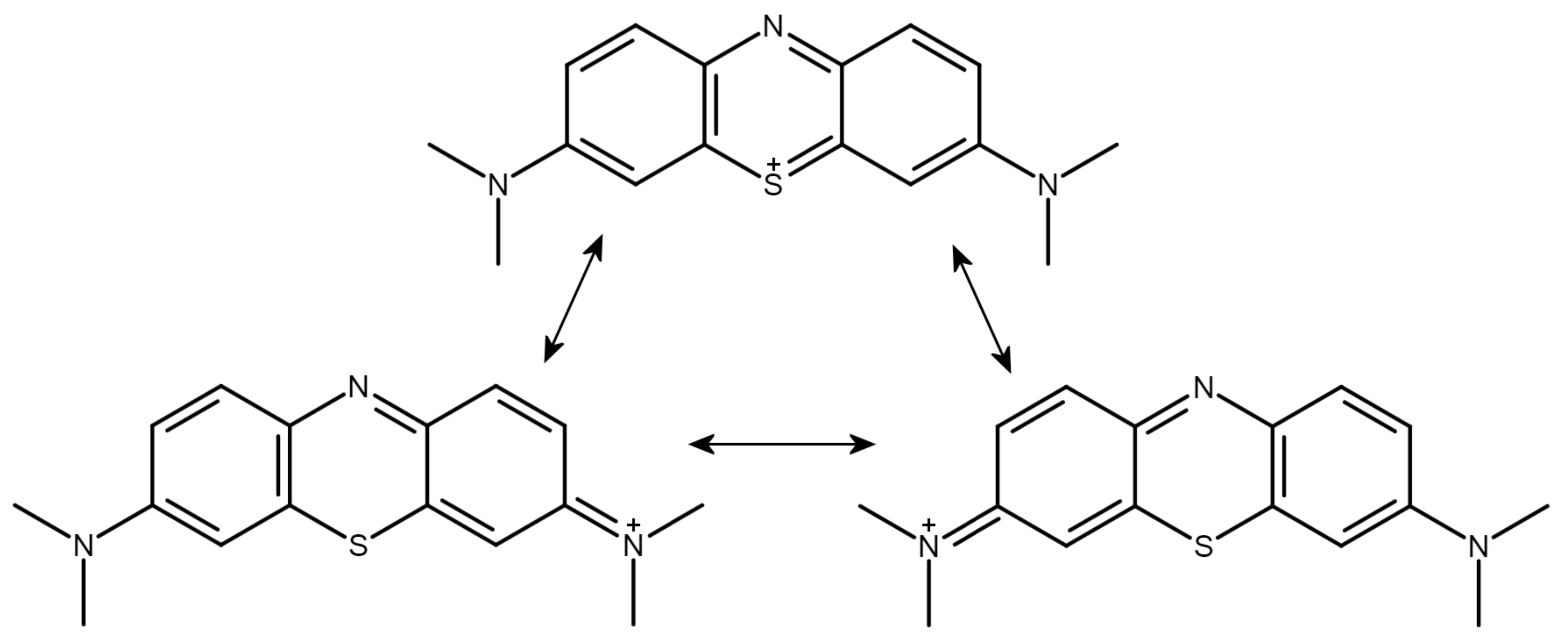

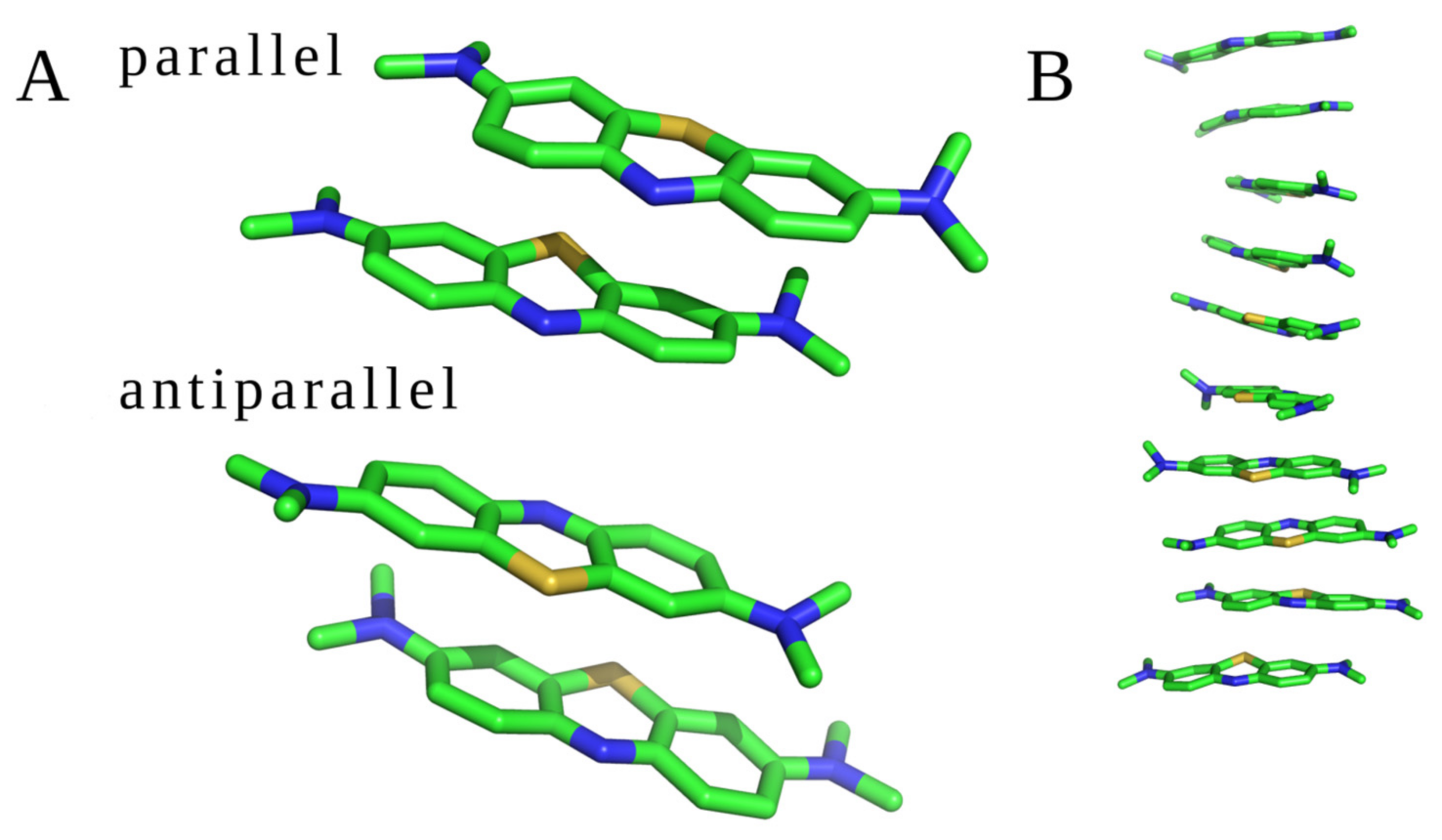
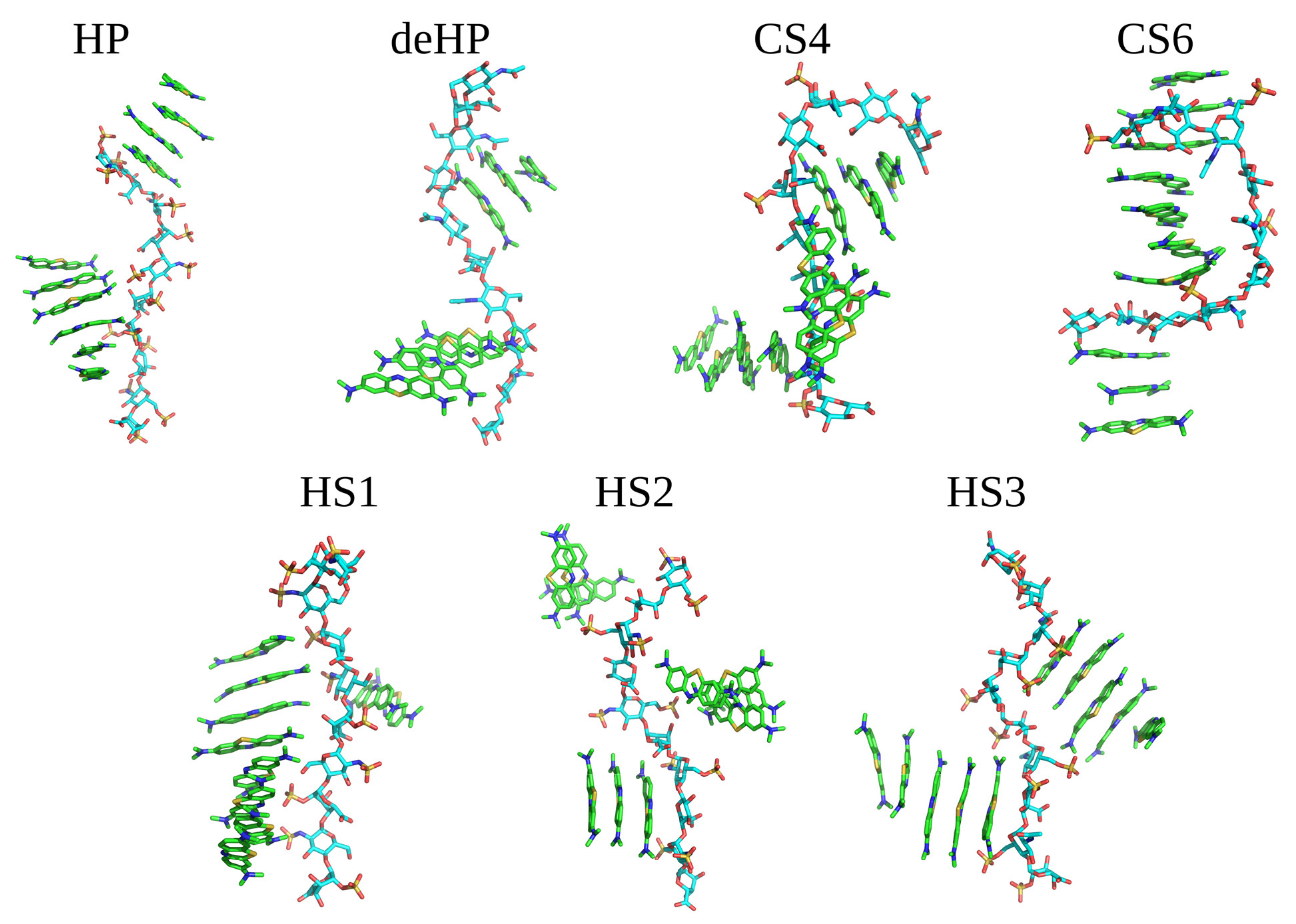
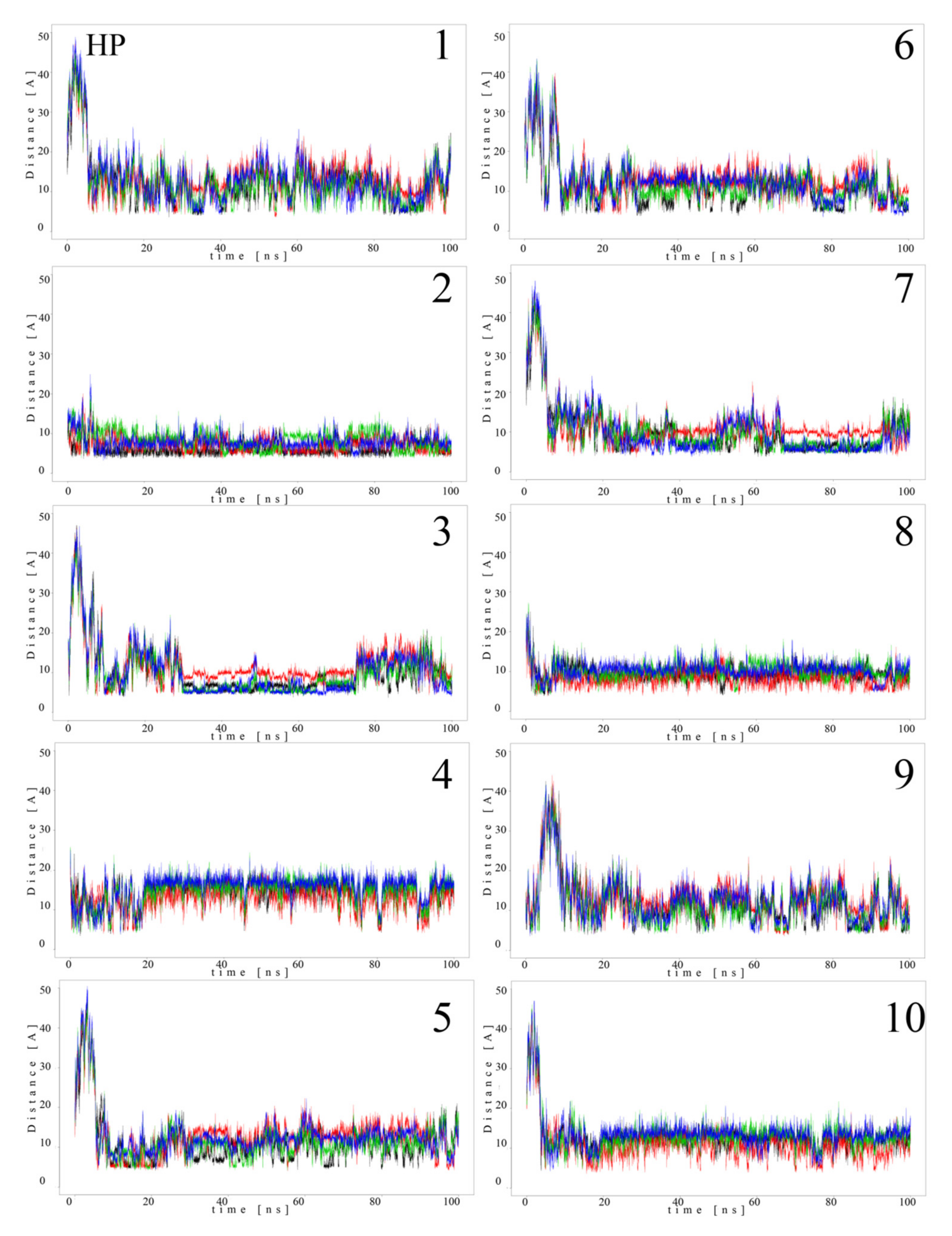
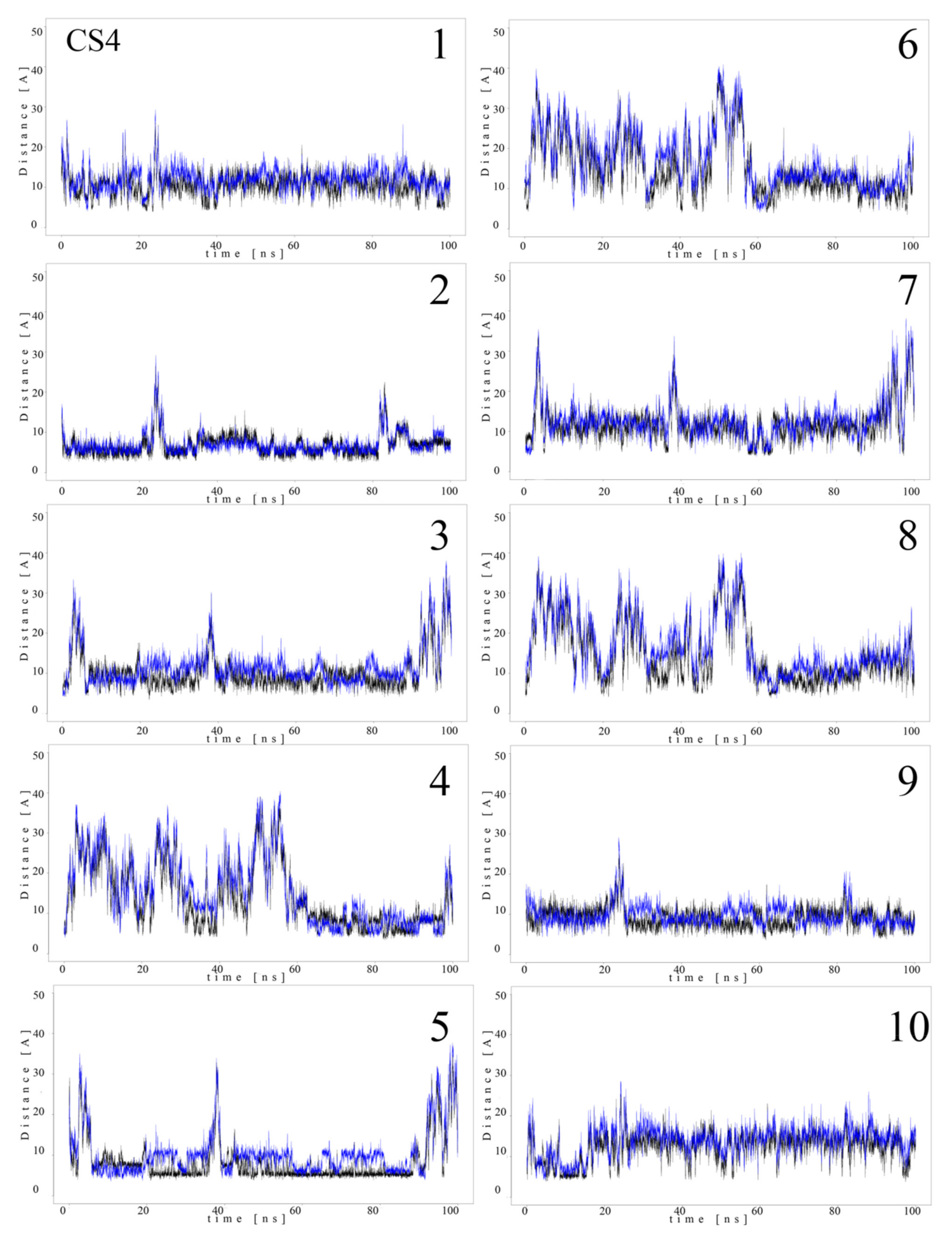
| System | Number of Drug Interacting | ∆G | ∆G/Drugs Number | ∆GvdW | ∆GVdW/Drugs Number | ∆Geel | ∆Geel/Drugs Number | ∆Gesurf | ∆Gesurf/Drug Number | ∆Geel + ∆Gegb | ∆Geel + ∆Gegb/Drugs Number |
|---|---|---|---|---|---|---|---|---|---|---|---|
| MB–MB | 2 | −13.0 | −6.5 | −15.1 | −7.5 | 44.6 | 22.3 | −1.0 | −0.5 | 3.1 | 1.5 |
| HP/MB | 10 | −55.0 | −5.5 | −44.6 | −4.5 | −3263.4 | −326.3 | −5.1 | −0.5 | −5.4 | −0.5 |
| deHP/MB | 7 | −2.8 | −0.3 | 0.0 | 0.0 | −174.1 | −17.4 | 0.0 | 0.0 | −2.1 | −0.2 |
| CS4/MB | 10 | −43.6 | −4.4 | −45.7 | −4.6 | −1679.2 | −167.9 | −4.2 | −0.4 | 6.4 | 0.6 |
| CS6/MB | 10 | −50.0 | −5.0 | −50.5 | −5.1 | −1861.6 | −186.2 | −5.0 | −0.5 | 5.6 | 0.6 |
| HS1/MB | 10 | −29.9 | −3.0 | −22.4 | −2.2 | −2209.2 | −220.9 | −3.1 | −0.3 | −4.5 | −0.5 |
| HS2/MB | 10 | −55.5 | −5.6 | −55.2 | −5.5 | −2322.3 | −232.2 | −5.4 | −0.5 | 5.0 | 0.5 |
| HS3/MB | 10 | −20.3 | −2.0 | −11.3 | −1.1 | −1639.1 | −163.9 | −1.4 | −0.1 | −7.6 | −0.8 |
| Lp | GAG dp10 | nMB | nSO3− | t | D |
|---|---|---|---|---|---|
| 1 | HP | 10 | 15 | 0.42 | 0.28 |
| 2 | deHP | 7 | 0 | - | - |
| 3 | CS4 | 10 | 5 | 0.30 | 0.60 |
| 4 | CS6 | 10 | 5 | 0.50 | 1.00 |
| 5 | HS1 | 10 | 10 | 0.30 | 0.30 |
| 6 | HS2 | 10 | 10 | 0.50 | 0.50 |
| 7 | HS3 | 10 | 10 | 0.10 | 0.10 |
| Lp | GAG dp10 | % of the Low Distance * with N-Sulfates | % of the Low Distance * with 4-Sulfates | % of the Low Distance * with 6-Sulfates | % of the Low Distance * with 2-Sulfates | % of the Low Distance * with Carboxylate Group |
|---|---|---|---|---|---|---|
| 1 | HP | 29.7 | - | 20.3 | 22.0 | 23.6 |
| 2 | deHP | - | - | - | - | 13.4 |
| 3 | CS4 | - | 30.2 | - | - | 21.1 |
| 4 | CS6 | - | - | 28.4 | - | 29.1 |
| 5 | HS1 | 29.9 | - | - | 31.5 | 25.9 |
| 6 | HS2 | 19.3 | - | 31.6 | - | 30.1 |
| 7 | HS3 | - | - | 28.4 | 23.0 | 1.6 |
Publisher’s Note: MDPI stays neutral with regard to jurisdictional claims in published maps and institutional affiliations. |
© 2022 by the authors. Licensee MDPI, Basel, Switzerland. This article is an open access article distributed under the terms and conditions of the Creative Commons Attribution (CC BY) license (https://creativecommons.org/licenses/by/4.0/).
Share and Cite
Maszota-Zieleniak, M.; Zsila, F.; Samsonov, S.A. Molecular Dynamics Approaches Dissect Molecular Mechanisms Underlying Methylene Blue–Glycosaminoglycan Interactions. Molecules 2022, 27, 2654. https://doi.org/10.3390/molecules27092654
Maszota-Zieleniak M, Zsila F, Samsonov SA. Molecular Dynamics Approaches Dissect Molecular Mechanisms Underlying Methylene Blue–Glycosaminoglycan Interactions. Molecules. 2022; 27(9):2654. https://doi.org/10.3390/molecules27092654
Chicago/Turabian StyleMaszota-Zieleniak, Martyna, Ferenc Zsila, and Sergey A. Samsonov. 2022. "Molecular Dynamics Approaches Dissect Molecular Mechanisms Underlying Methylene Blue–Glycosaminoglycan Interactions" Molecules 27, no. 9: 2654. https://doi.org/10.3390/molecules27092654
APA StyleMaszota-Zieleniak, M., Zsila, F., & Samsonov, S. A. (2022). Molecular Dynamics Approaches Dissect Molecular Mechanisms Underlying Methylene Blue–Glycosaminoglycan Interactions. Molecules, 27(9), 2654. https://doi.org/10.3390/molecules27092654







